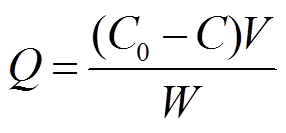 ,
, 陶虎春 † 刘威 黄帅斌 程玲
北京大学深圳研究生院环境与能源学院, 深圳市重金属污染控制与资源化重点实验室, 深圳 518055
摘要 采用沉淀聚合法, 以PdCl 4 2 − 为模板, 以4-乙烯基吡啶(4-VP)、2-烯丙巯基烟酸(ANA)、2-乙酸胺基丙烯酸(AAA)为功能单体, 加入交联剂二甲基丙烯酸乙二醇酯(EGDMA)、引发剂偶氮二异丁腈(AIBN)和致孔剂甲醇, 制备钯离子印迹聚合物。通过添加不同种类、用量的功能单体和不同用量的交联剂, 探究不同制备条件对钯离子印迹聚合物制备效果的影响。优化结果表明, 与ANA和AAA功能单体对比, 4-VP和PdCl 4 2– 能形成4:1的稳定配合物, 结合常数最大, 印迹效果最好, 是3种功能单体中用于制备钯离子印迹聚合物的最佳选择。吸附试验结果进一步表明, 按照模板、功能单体、交联剂用量比例为1:4:40制备的钯离子印迹聚合物对Pd(II)的吸附量最大, 为5.042 mg/g。
关键词 钯离子印迹聚合物; 功能单体; 吸附
钯(palladium, Pd)属于铂族金属, 因其独特的物理和化学性质(尤其是催化性能), 广泛用于电镀材料、催化剂、牙科合金、钎焊合金等 [1–2] 。随着钯的应用范围不断扩大, 在环境中的浓度也不断增加, 含钯的废液不仅会对环境造成污染, 还会对人类健康造成危害。作为一种贵金属, 钯具有回收价值, 任意排放也会造成严重的资源浪费 [3–6] 。目前钯在环境中处于 ng/g (或 ng/mL)的水平, 因分析物与基质成分之间的相互作用明显地影响检测限和分析方法的准确性, 所以直接测定环境样品中钯(II)的含量比较困难 [7] 。分离富集可以解决以上问题, 常用的分离富集方法有离子交换法 [7] 、共沉淀法 [8] 、固相萃取法 [9] 、液液萃取法 [10] 、液液微萃法 [11] 以及云点萃取法 [12] 等。关于钯的分离富集的研究已有很多 [13–17] , 其中固相萃取吸附法应用较广, 但常见的吸附剂(如活性炭、高分子膜等)对特定金属离子不具备选择吸附性。因此, 制备具有高选择吸附性的钯分离材料, 从含钯的废液中高效快捷地分离提取钯具有重要意义。
与其他吸附剂相比, 具有高选择吸附性的离子印迹聚合物(IIP)在分离富集特定金属离子方面有广泛的应用前景 [18–22] 。在离子印迹聚合物的制备中, 带有不同官能团的功能单体与模板离子通过离子键、配价键等作用形成螯合物, 其与离子作用的强弱决定该螯合物的稳定性。二者相互作用越强, 所形成的聚合物对目标离子的吸附能力就越强, 进而对吸附性能的影响就越大。因此, 对功能单体的筛选尤为重要 [23–31] 。交联剂的作用是在钯离子印迹聚合物的合成过程中, 使功能单体与模板离子发生反应, 并使其固定在模板离子周围的特定位置上, 从而形成交联度和刚性很强的立体网状聚合物 [32–33] 。因此, 交联剂的用量会影响合成的钯离子印迹聚合物的结构, 进而影响其吸附性能。
本研究选取应用较广的氮杂环类功能单体4-VP以及两种研究较少的羧基类功能单体ANA和AAA来制备钯离子印迹聚合物, 通过紫外光谱以及吸附容量的对比, 考察不同功能单体种类和用量对Pd(Ⅱ) IIPs吸附Pd(Ⅱ)性能的影响, 同时对交联剂用量的影响进行研究, 为钯离子印迹聚合物在制备中的优化研究提供参考。
主要仪器: TAS-990原子吸收分光光度计(北京普析通用), UV-2600型紫外可见分光光度计(日本岛津), SHZ-88水浴恒温振荡器(金坛市医疗仪器厂), HZQ-X500C恒温振荡器(上海一恒科学仪器有限公司), DZF-6020型真空干燥箱(上海浦东荣丰科学仪器有限公司)。
主要试剂: K 2 PdCl 4 、4-乙烯基吡啶(4-VP, 96%)、2-烯丙巯基烟酸(ANA, 98%)、2-乙酸胺基丙烯酸(AAA, 99%)和二甲基丙烯酸乙二醇酯(EGDMA, 98%)均购自美国Alfa公司, 偶氮二异丁腈(AIBN, 99%), 购买自上海百灵威化学技术有限公司, 钯单元素标准溶液购自国家标准物质网(http://www. bzwz.com)。
实验中所用试剂均为分析纯, 实验用水为超纯水。
1.2.1 钯离子与不同功能单体相互作用的紫外光谱
用甲醇配制Pd(II)的浓度为1 mmol/L, 取含 1 mL PdCl 4 2– (酸性条件下 Pd(II)的主要形式)的甲醇溶液加入一系列10 mL的比色管中, 然后分别加入 1 mL 浓度为 3mmol/L 的不同功能单体(4-VP, ANA和 AAA)的甲醇溶液, 用甲醇定容到 10mL 后摇匀。以相同浓度对应的功能单体的甲醇溶液为参比, 在波长为 200~400nm 范围下, 获得 Pd(II)与各种功能单体在甲醇中相互作用体系的紫外光谱。
1.2.2 钯离子印迹聚合物的制备
采用沉淀聚合法, 以 PdCl 4 2– 作为模板离子, 以4-VP, ANA 和 AAA 为功能单体, 加入交联剂EGDMA 和引发剂 AIBN, 按照模板:功能单体:交联剂=1:4:40制备印迹聚合物, 操作步骤如下。
称取0.1 mmol K 2 PdCl 4 置于装有20 mL甲醇的离心管中, 向其中加入0.4 mmol的功能单体, 置于恒温振荡器中(180 r/min, 25ºC)振荡反应 3 小时, 待Pd(II)与功能单体充分反应后, 加入 4mmol的交联剂EGDMA和36.13 mg的引发剂AIBN(用量为功能单体与交联剂摩尔量之和的 5%)。充分混合后, 转入厚壁耐压瓶中, 通氮气10分钟, 在氮气保护下迅速封瓶, 然后以 180r/min 的振荡速率在 60ºC 下水浴恒温振荡反应 24 小时, 为防止水浴恒温振荡器中水分蒸干, 间隔固定时间加水。热聚合反应后, 将厚壁耐压瓶中合成的聚合物转移到大口径的磨口锥形瓶中, 用 1:4 (体积比)的甲醇 - 水混和液清洗聚合物几次, 除去致孔剂、引发剂和未反应的功能单体等, 然后用 4 份 50 mL 体积比为 50%的 HCl 对聚合物洗脱24小时, 直至检测不到 Pd(II), 再用去离子水反复洗涤至上清液的 pH 呈中性。所得样品用台式冷冻离心机(Hettuch 320R, 德国)以 5000 r/min的转速在 25ºC 下离心 15 分钟, 弃上清液。将装有聚合物的离心管放入真空干燥箱中, 在 60ºC 下干燥 48 小时, 即得到钯离子印迹聚合物(IIP)。
非离子印迹聚合物(NIP)的制备除不加K 2 PdCl 4 外, 其余均与上述制备IIP的方法相同。
1.2.3 吸附及测定
取10 mg钯离子印迹聚合物和非离子印迹聚合物于 50mL 的离心管中, 加入 10mL Pd(II)溶液( C =10 mg/L, pH=2), 置于恒温振荡器中振荡吸附5小时(180 r/min, 25ºC), 用 0.45μm 滤头过滤, 取清液, 用火焰原子吸收法(FAAS)测定Pd(II)的浓度。
1.3.1 平衡吸附量和印迹因子
本研究通过平衡吸附量 Q 及印迹因子 α , 对比3种功能单体制备的钯离子印迹聚合物的吸附性能, 计算方程如下。
 ,
,  ,
,
其中, Q 为每克钯离子印迹聚合物吸附的 Pd(II) 的量(mg/g), C 0 为 Pd(II)的原始浓度(mg/L), C 为吸附平衡后溶液中剩余的Pd(II)浓度(mg/L), V 为吸附溶液的总体积(mL), W 为加入的钯离子印迹聚合物的量(g), Q IIP 钯离子印迹聚合物的平衡吸附量(mg/g),  为非离子印迹聚合物的平衡吸附量(mg/g)。
为非离子印迹聚合物的平衡吸附量(mg/g)。
1.3.2 结合常数和配位比
设印迹离子 Pd 2+ 与功能单体 L 之间发生的反应为
 ,
, 则Pd 2+ 与功能单体L的结合常数
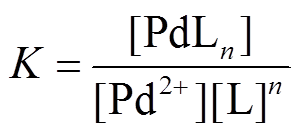 , (1)
, (1)
其中,  为反应平衡时Pd 2+ 的浓度,
为反应平衡时Pd 2+ 的浓度,  为反应平衡时功能单体的浓度,
为反应平衡时功能单体的浓度,  为反应生成的PdL n 的平衡浓度。
为反应生成的PdL n 的平衡浓度。
若参加反应的 Pd 2+ 与 L 的初始浓度分别为  和
和 ![]() , 根据物料守恒可得
, 根据物料守恒可得
 , (2)
, (2)  。 (3)
。 (3)
当  , 即加入的功能单体L的浓度远大于Pd 2+ 的浓度时, 式(3)中的
, 即加入的功能单体L的浓度远大于Pd 2+ 的浓度时, 式(3)中的  可以忽略不计, 则式(3)简化为
可以忽略不计, 则式(3)简化为
 。 (4)
。 (4) 根据式(2)~(4), 可得
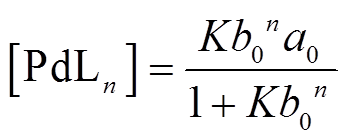 。 (5)
。 (5)
在测量波长范围内, 若Pd 2+ , L 和 PdL n 在甲醇溶液中都有吸收, 则预聚合体系的吸光度为

 (6)
(6)
其中, l 为波长。
以甲醇溶液做参比时, 设Pd 2+ 和L在甲醇溶液中的吸光度  和
和  分别为
分别为  和
和  , 则 PdL n 的吸光度为
, 则 PdL n 的吸光度为


 。 (7)
。 (7)
根据式(5)和(7), 可得
 。 (8)
。 (8) 令式(8)中的 n 分别为1, 2, 3, …, 计算相应的  , 用
, 用  对
对  作图, 拟合得到一条直线, 该直线的斜率即为Pd 2+ 与功能单体 L 的结合常数 K , 此时的 n 即为二者的配合比。
作图, 拟合得到一条直线, 该直线的斜率即为Pd 2+ 与功能单体 L 的结合常数 K , 此时的 n 即为二者的配合比。
2.1.1 不同功能单体与PdCl 4 2– 相互作用的紫外光谱
图 1 是 PdCl 4 2– 与 3 种功能单体 4-VP, ANA 和AAA 在甲醇中相互作用前后的紫外光谱图。可以看出, PdCl 4 2– 在 219.4 和 242.4nm处有两个吸收峰, 当加入不同功能单体时, 吸收峰都发生一定程度的变化。当加入的功能单体是 4-VP 时, PdCl 4 2– 在219.4 和 242.4nm处的吸收峰出现明显的减色效应, 而在 275nm附近形成新的吸收峰且与 219.4nm的吸收峰相比是增色效应, 说明 PdCl 4 2– 与 4-VP 在275 nm附近反应剧烈, 结构有明显的变化。当加入 ANA 到 PdCl 4 2– 的甲醇溶液后, 不仅使 PdCl 4 2– 在 219.4 和 242.4nm 处的两个吸收峰发生红移现象, 而且在 285 和 347nm附近产生两个新的吸收峰, 与 219.4 nm处的吸收峰相比, 新形成的两处吸收峰出现减色效应, 说明PdCl 4 2– 与 ANA在 285 和347nm 附近有反应, 结构有一定程度的变化。AAA 的加入并没有使 PdCl 4 2– 在 219.4 和 242.4nm处的吸收峰发生红移或蓝移, 也没有形成新的吸收峰, 说明 PdCl 4 2– 与 AAA 之间的反应很弱, 结构变化不大。因此推测, 4-VP 与 PdCl 4 2– 的相互作用最强, ANA次之, AAA最弱。
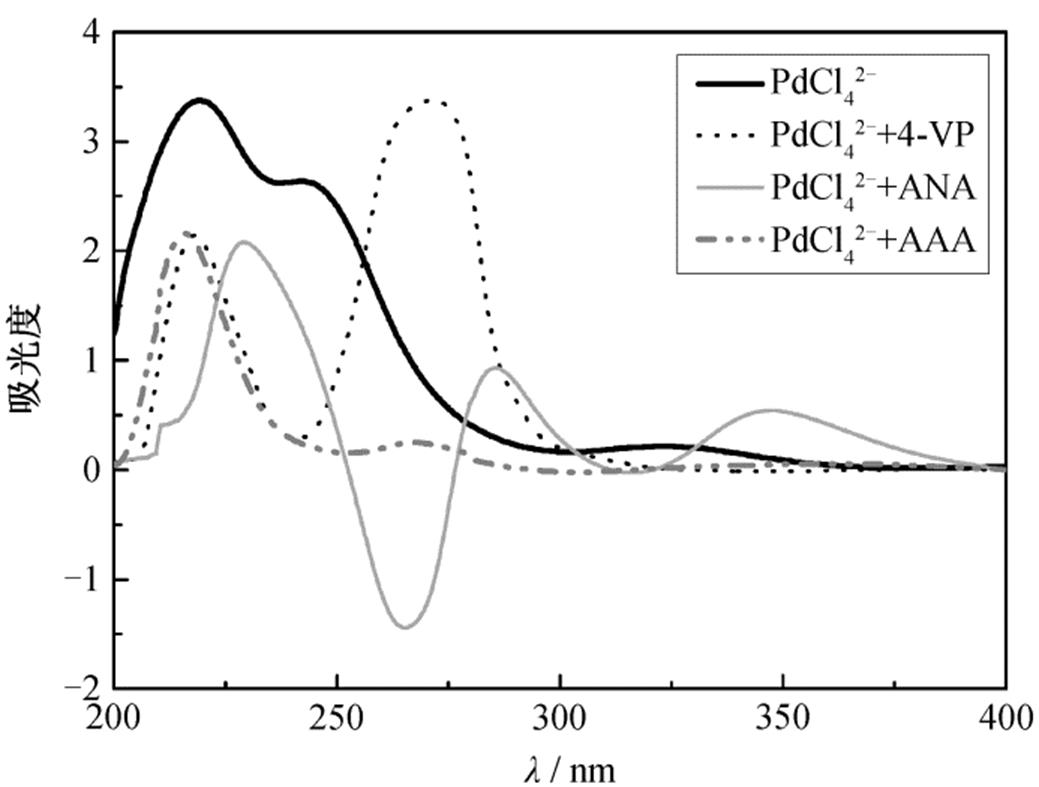
图1 PdCl 4 2– 与功能单体4-VP, ANA 和 AAA 在甲醇中相互作用的紫外光谱
Fig. 1 Ultraviolet spectra of the interaction between PdCl 4 2– and 4-VP, ANA and AAA in methanol
2.1.2 不同功能单体与 PdCl 4 2– 相互作用的结合常数和配合比
紫外全波长扫描从宏观上展示 3 种功能单体4-VP, ANA和AAA与模板PdCl 4 2– 之间相互作用而产生的结构变化, 为判断它们之间相互作用的强弱提供了辅助参考。为了进一步确定它们相互作用的强弱, 我们根据紫外光谱的数据, 计算不同功能单体与PdCl 4 2– 相互作用的结合常数和配合比, 结果如表1所示。
从表1可知, PdCl 4 2– 与4-VP, ANA和AAA之间的结合常数 K 和配合比 n 有所不同。其中PdCl 4 2– 与4-VP能形成配合比为1:4的配合物, 与ANA和AAA能形成1:1的配合物。PdCl 4 2– 与4-VP的结合常数最大(3.1926×10 14 ), ANA次之(6.9042×10 3 ), AAA最小(2.373×10 3 ), 说明与其他两种功能单体相比, 4-VP与PdCl 4 2– 的相互作用最强。
2.1.3 不同功能单体制备的钯离子印迹聚合物的印迹因子和吸附性能比较
3 种功能单体 4-VP, ANA 和 AAA 制备的钯离子印迹聚合物对 Pd(II)的吸附效果如表 2 以及图 2所示。
从图2可以看出, 在形成的3种聚合物中, 钯离子印迹聚合物的吸附量均大于对应的非离子印迹聚合物, 说明同一种聚合物的IIP和NIP在空间结构上存在显著的差异, 在IIP的形成过程中, 由于加入印迹离子PdCl 4 2– , 使得功能单体与PdCl 4 2– 形成具有配位功能的印迹空穴, 而这种空穴对Pd(II)呈现 “记忆功能”, 导致IIP比NIP吸附Pd(II)量多。此外, 3种聚合物对Pd(II)的吸附量从多到少依次是4-VP, ANA, AAA, 这主要由4-VP独有的结构导致。4-VP中含带孤对电子的N原子, 不仅使得4-VP与Pd(II)可以发生配位螯合, 还可以与羧基(-COOH)、羟基(-OH)等官能团形成氢键。此外, 4-VP带有的乙烯官能团能与交联剂发生聚合反应, 将N原子挂在聚合物的链上, 从而形成弱碱性的聚电解质 [34] 。从表2可以看出, 在所有的聚合物中, 由4-VP制备的IIP和NIP所得的印迹因子 α 最大, 说明由4-VP制备的聚合物印迹效果最好。所以无论是从对Pd(II)的吸附量还是印迹效果来看, 由4-VP制备的钯离子印迹聚合物都是效果最好的, 与对紫外光谱和结合常数的分析结果一致。
表1 Pd (II)与不同功能单体相互作用的结合常数( K )与配合比( n )
Table 1 Binding constant K and mole ratio n of Pd (II) with different function monomers

表2 不同功能单体制备钯离子印迹聚合物的印迹因子 α
Table 2 Imprinting factor α of different palladium ion imprinted polymers

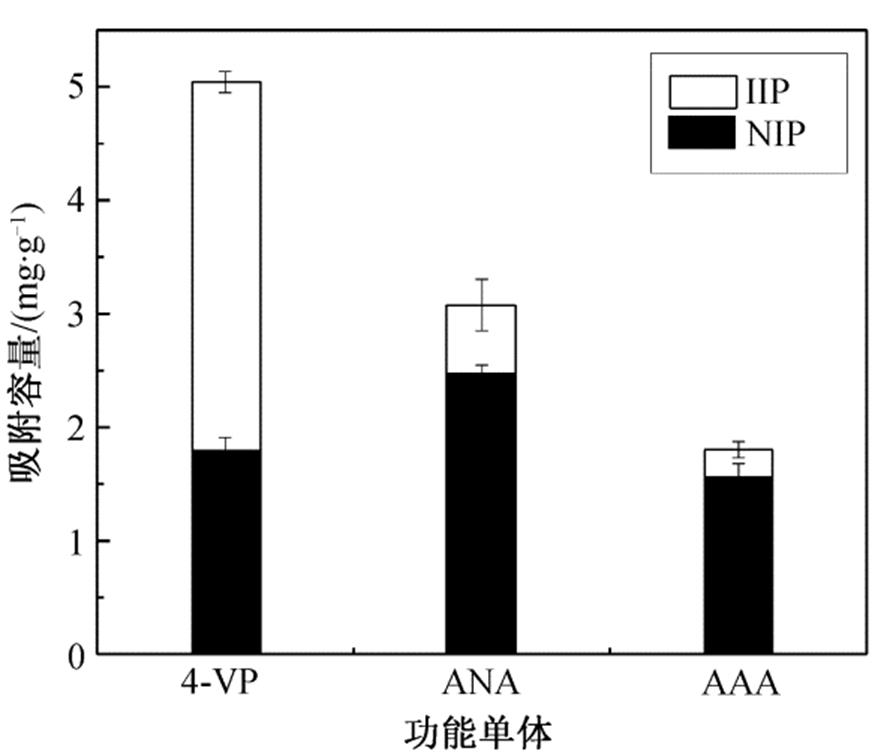
图2 不同功能单体制备的钯离子印迹聚合物的吸附性能
Fig. 2 Adsorption properties of palladium ion imprinted poly- mers synthesized by different function monomers
表3 同功能单体用量制备的钯离子印迹聚合物的印迹因子 α
Table 3 Imprinting factor α of palladium ion imprinted polymers synthesized by different functional monomer dosage
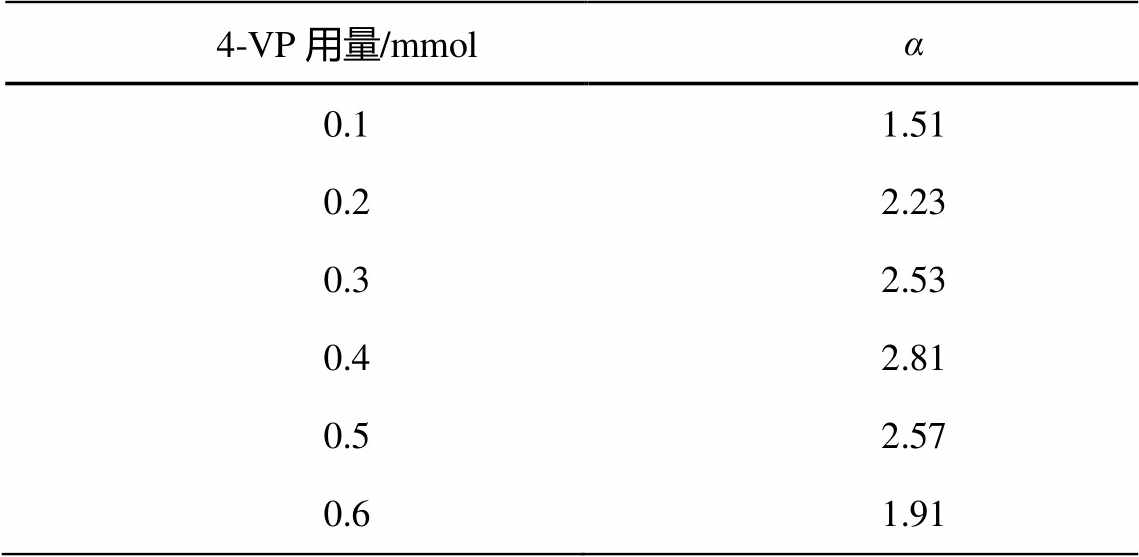
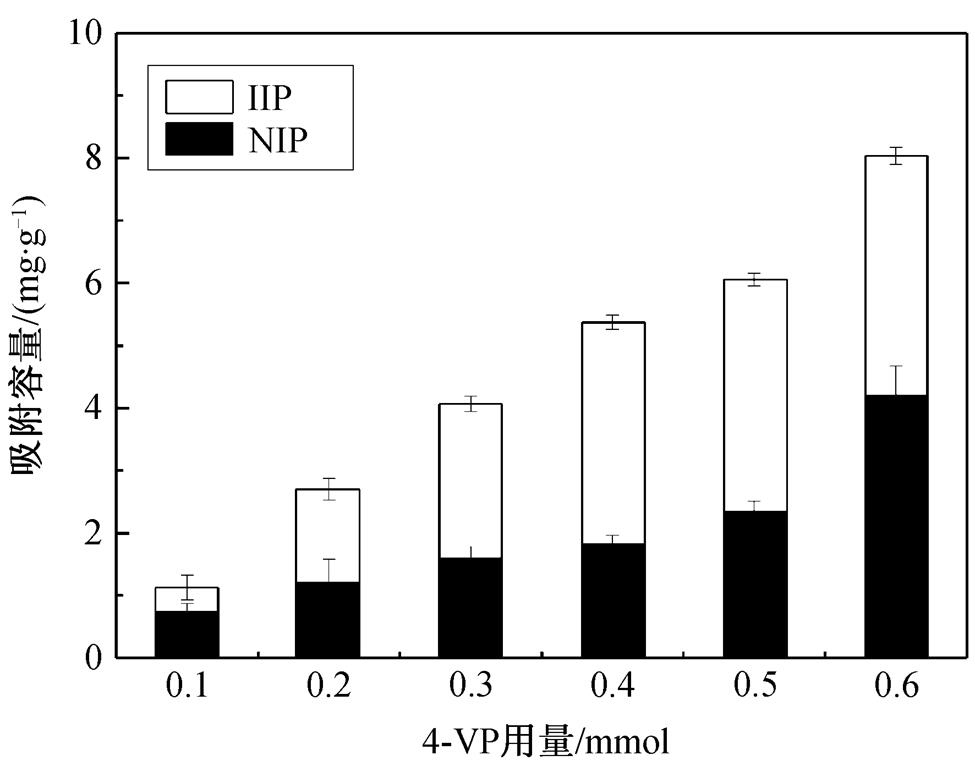
图4 不同功能单体用量制备的钯离子印迹聚合物的吸附性能
Fig. 4 Adsorption properties of palladium ion imprinted polymers synthesized by different function mono-mers dosage
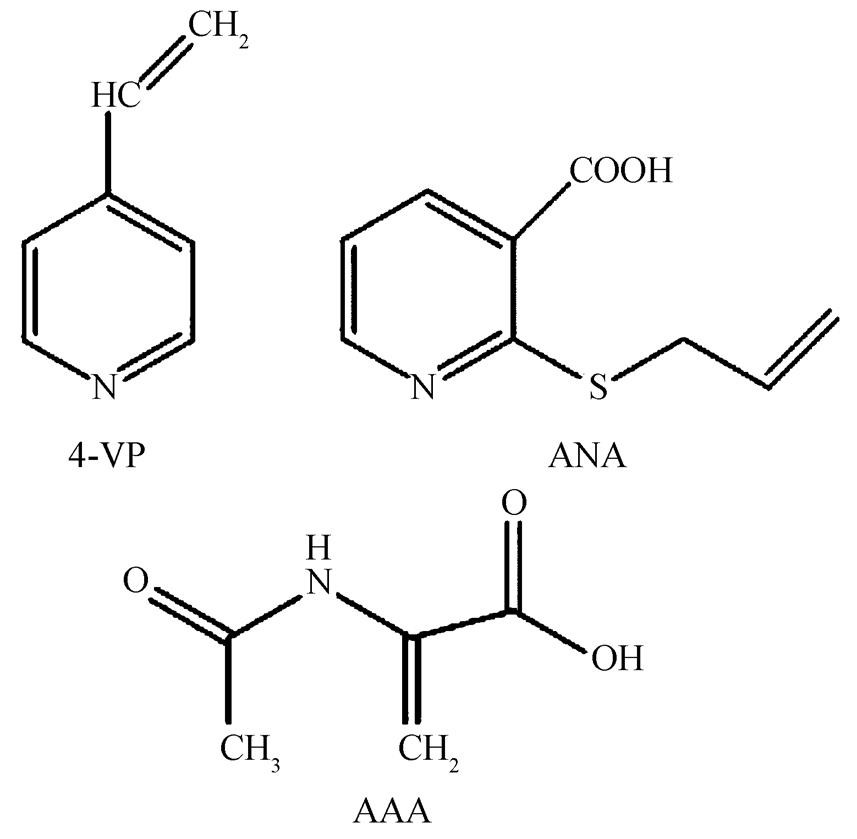
图3 3种功能单体的结构图
Fig. 3 Structural formula of three functional monomers
对比3种功能单体的结构图(图3)发现, 4-VP和ANA均含氮杂环, ANA和AAA含羧基, 结合紫外和结合常数的结果推测, 氮杂环类的功能单体比羧基类功能单体与Pd(Ⅱ)的结合作用强, 且当功能单体同时含氮杂环和羧基时, 羧基的存在会削弱功能单体与Pd(Ⅱ)的结合作用。
在固定模板与交联剂用量比为1:40条件下, 以4-VP作为功能单体, 研究其不同用量对钯离子印迹聚合物吸附Pd(II)的影响, 结果如表3和图4所示。
从图4可以看出, 随着功能单体4-VP的用量增加, 钯离子印迹聚合物IIP对Pd(II)的吸附量逐渐增大, 非离子印迹聚合物NIP对Pd(II)的吸附量也逐渐增大, 这主要是因为4-VP用量增加后, 与模板离子PdCl 4 2– 相互作用的功能单体增加, 从而产生更多的结合位点, 增加了对Pd(II)的吸附量。结合表 3 中不同功能单体用量制备的钯离子印迹聚合物的印迹因子 α 可知, 当功能单体4-VP用量为0.4 mmol 时, 即模板、功能单体、交联剂用量比为1:4:40 时, 制备出的钯离子印迹聚合物的 α 最大, 说明此时的印迹效果最好。
在固定模板与功能单体4-VP用量比为1:4的条件下, 以EGDMA作为交联剂, 研究其不同用量对钯离子印迹聚合物吸附Pd(II)的影响, 结果如表4和图5所示。
表4 不同功能单体制备钯离子印迹聚合物的印迹因子α
Table 4 Imprinting factor α of different palladium (Ⅱ) ion imprinted polymers


图5 不同4-VP用量对制备的钯离子印迹聚合物的吸附性能
Fig. 5 Adsorption properties of palladium (Ⅱ) ion imprinted polymers synthesized by different dosage of 4-VP
从图 5 可以看出, 随着交联剂EGDMA用量的增加, 钯离子印迹聚合物 IIP 对 Pd(II)的吸附量逐渐降低, 非离子印迹聚合物 NIP 对Pd(II)的吸附量也逐渐降低。在EGDMA用量较少(即 1 和 2 mmol)时, 钯离子印迹聚合物 IIP 和非离子印迹聚合物NIP 对 Pd(II)的吸附量很大, 这是因为交联剂用量较少时, 聚合物链间的空隙大, Pd(II)可以较快地通过扩散作用进入识别位点。当 EGDMA 用量增加时, 不仅使交联剂之间发生缔合作用而阻碍印迹聚合物的生成, 而且也导致合成的钯离子印迹聚合物具有较高的交联度和刚性, 降低 Pd(II)接近聚合物的可能性, 从而减少钯离子印迹聚合物 IIP 和非离子印迹聚合物NIP对Pd(II)的吸附量。结合表4中不同功能单体用量制备的钯离子印迹聚合物的α值可知, 当功能单体4-VP用量为 0.4 mmol时, 即模板、功能单体、交联剂用量比为 1:4:40 时, 制备出的钯离子印迹聚合物的 α 值最大, 说明此时的印迹效果最好。
本研究选取氮杂环类功能单体4-VP以及两种羧基类功能单体ANA和AAA, 来制备钯离子印迹聚合物。考察了不同功能单体种类、用量及交联剂用量对Pd(II) IIPs吸附Pd(II)性能的影响, 为钯离子印迹聚合物的制备优化提供参考, 得到如下结论。
1)紫外光谱、结合常数和配合比的结果表明, 4-VP, ANA和AAA与PdCl 4 2– 可分别形成4:1, 1:1和 1:1的配合物, 其中4-VP的结合常数最大, ANA次之, AAA最小。
2)3种功能单体中, 4-VP制备的IIP对Pd(II)的吸附量最大, 可达到5.042 mg/g, 且印迹效果最好。
3)当模板、功能单体、交联剂用量比为1:4:40时, 制备的钯离子印迹聚合物对Pd(II)的吸附效果最佳。
参考文献
[1]Amatore C, Jutand A. Mechanistic and kinetic studies of palladium catalytic systems. J Organomet Chem, 1999, 576(1/2): 254–278
[2]Li Y, Li T, Yan L, et al. Preparation and characteri-zation of electrospun copoly (phthalazinone biphenyl ether ketone) superfine fibrous membrane served as plating template of Pd. Mater Lett, 2016, 167: 148–152
[3]Moldovan M, Palacios M A, Gomez M M, et al. Envi-ronmental risk of particulate and soluble platinum group elements released from gasoline and diesel engine catalytic converters. Sci Total Environ. 2002, 296: 199–208
[4]Ek K H, Morrison G M, Rauch S. Environmental routes for platinum group elements to biological materials —a review. Sci Total Environ, 2004, 334/335: 21–38
[5]Merget R, Rosner G. Evaluation of the health risk of platinum group metals emitted from automotive cata-lytic converters. Sci Total Environ, 2001, 270: 165–173
[6]Wang Y, Li X. Health risk of platinum group elements from automobile catalysts. Procedia Engineering, 2012, 45: 1004–1009
[7]Hubicki Z, Wołowicz A. A comparative study of che-lating and cationic ion exchange resins for the removal of palladium(II) complexes from acidic chloride me-dia. J Hazard Mater, 2009, 164(2/3): 1414–1419
[8]Soylak M, Tuzen M. Coprecipitation of gold (III), palladium(II) and lead(II) for their flame atomic absorption spectrometric determinations. J Hazard Mater, 2008, 152(2): 656–661
[9]Fayemi O E, Ogunlaja A S, Kempgens P F M, et al. Adsorption and separation of platinum and palladium by polyamine functionalized polystyrene-based beads and nanofibers. Miner Eng, 2013, 53: 256–265
[10]Kasatkin I A, Degtev M I, Toropov L I. Liquid-liquid extraction of palladium (II) in diantipyrylalkane-benzoic acid-HCl-H 2 O stratifying systems. Mendeleev Commun, 2015, 25(5): 391–392
[11]Eskandari H. In situ formed 1-hexyl-3-methylimida-zolium hexafluorophosphate for dispersive liquid-liquid microextraction of Pd (II) prior to electro-thermal AAS and spectrophotometry. Turk J Chem, 2012, 36(4): 631–643
[12]Suoranta T, Zugazua O, Niemelä M, et al. Recovery of palladium, platinum, rhodium and ruthenium from catalyst materials using microwave-assisted leaching and cloud point extraction. Hydrometallurgy, 2015, 154: 56–62
[13]Ozturk N, Bulut V N, Duran C, et al. Coprecipitation of palladium(II) with 1,5-diphenylcarbazite–copper (II) and determination by flame atomic absorption spectrometry. Desalination, 2011, 270: 130–134
[14]Afzali D, Jamshidi R, Ghaseminezhad S, et al. Pre-concentration procedure trace amounts of palladium using modified multiwalled carbon nanotubes sorbent prior to flame atomic absorption spectrometry. Arab J Chem, 2012, 5(4): 461–466
[15]Wołowicz A, Hubicki Z. Investigation of macroporous weakly basic anion exchangers applicability in palla-dium(II) removal from acidic solutions—batch and column studies. Chem Eng J, 2011, 174: 510–521
[16]Godlewska-Żyłkiewicz B, Leśniewska B, Wawreniuk I. Assessment of ion imprinted polymers based on Pd (II) chelate complexes for preconcentration and FAAS determination of palladium. Talanta, 2010, 83(2): 596–604
[17]Kokya T A, Farhadi K. Optimization of dispersive liquid – liquid microextraction for the selective deter-mination of trace amounts of palladium by flame ato-mic absorption spectroscopy. J Hazard Mater, 2009, 169: 726–733
[18]Bojdi M K, Mashhadizadeh M H, Behbahani M, et al, Synthesis, characterization and application of novel lead imprinted polymer nanoparticles as a high se-lective electrochemical sensor for ultra-trace deter-mination of lead ions in complex matrixes. Electro-chim Acta, 2014, 136: 59–65
[19]Liu H, Kong D, Sun W, et al. Effect of anions on the polymerization and adsorption processes of Cu(II) ion-imprinted polymers. Chem Eng J, 2016, 303: 348–358
[20]Corman M E, Armutcu C, Uzun L, et al. Reversible and easy post-crosslinking method for developing a surface ion-imprinted hypercrosslinked monolith for specific Cd(II) ion removal from aqueous solutions. Rsc Adv, 2016, 6(91): 88777–88787
[21]Rajabi HR, Razmpour S. Synthesis, characterization and application of ion imprinted polymeric nanobeads for highly selective preconcentration and spectropho-tometric determination of Ni 2+ ion in water samples. Spectrochimica Acta Part A: Molecular and Biomo-lecular Spectroscopy, 2016, 153: 45–52
[22]Zhang Q, Wu J, Luo X. Facile preparation of a novel Hg(II)-ion-imprinted polymer based on magnetic hybrids for rapid and highly selective removal of Hg(II) from aqueous solutions. Rsc Adv, 2016, 6(18): 14916–14926
[23]Karim K, Breton F, Rouillon R, et al. How to find effective functional monomers for effective molecu-larly imprinted polymers?. Adv Drug Deliver Rev, 2005, 57(12): 1795–1808
[24]Bojdi M K, Behbahani M, Sahragard A, et al. A palladium imprinted polymer for highly selective and sensitive electrochemical determination of ultra-trace of palladium ions. Electrochim Acta, 2014, 149: 108–116
[25]Daniel S, Prabhakara Rao P, Prasada Rao T. Investi-gation of different polymerization methods on the analytical performance of palladium(II) ion imprinted polymer materials. Anal Chim Acta, 2005, 536(1/2): 197–206
[26]Daniel S, Babu P, Rao T. Preconcentrative separation of palladium(II) using palladium(II) ion-imprinted polymer particles formed with different quinoline derivatives and evaluation of binding parameters based on adsorption isotherm models. Talanta, 2005, 65(2): 441–452
[27]Lin S, Wei W, Wu X, et al. Selective recovery of Pd(II) from extremely acidic solution using ion-imprinted chitosan fiber: Adsorption performance and mechanisms. J Hazard Mater, 2015, 299: 10–17
[28]Daniel S, Gladis J M, Rao T P. Synthesis of imprinted polymer material with palladium ion nanopores and its analytical application. Anal Chim Acta, 2003, 488(2): 173–182
[29]Daniel S, Praveen R S, Rao T P. Ternary ion-association complex based ion imprinted polymers (IIPs) for trace determination of palladium(II) in environmental samples. Anal Chim Acta, 2006, 570 (1): 79–87
[30]刘鹏, 云惟贤, 董宝莲, 等. 不同功能单体对钯(II)离子印迹聚合物性能的影响研究. 贵金属, 2010, 31(3): 38–42
[31]李丽萍. 钯(II)和铱(II)离子印迹聚合物的制备、性能及应用研究[D]. 昆明: 云南大学, 2012
[32]Okay O. Macroporous copolymer networks. Progress in Polymer Science, 2000, 25(6): 711–779
[33]Sellergren B. Polymer-and template-related factors influencing the efficiency in molecularly imprinted solid-phase extractions. Trac-Trends In Analytical Chemistry, 1999, 18(3): 164–174
[34]朱彩艳, 马慧敏, 张强, 等. 离子印迹聚合物功能单体的研究进展. 化工进展, 2014, 33(11): 3013–3020
Preparation and Optimization of a Palladium Ion Imprinted Polymer
TAO Huchun † , LIU Wei, HUANG Shuaibin, CHENG Ling
Shenzhen Key Laboratory for Heavy Metal Pollution Control and Reutilization, School of Environment and Energy, Peking University Shenzhen Graduate School, Shenzhen 518055
Abstract Palladium (II) ion imprinted polymers (IIP) were prepared by precipitation polymerization method using PdCl 4 2– as template, 4-vinylpridine(4-VP), 2-(allylthio)nicotinic acid (ANA), 2-Acetamidoacrylic acid (AAA) as functional monomer, respectively. In the polymerization method, the polymerization mixture included ethylene glycoldimethacrylate (EGDMA, cross-linking monomer), 2,2-azobisisobutyronitrile (AIBN, initiator) and methanol (porogen). The effects of different preparation conditions on the preparation of palladium ion imprinted polymers were investigated by the type of functional monomers, the dosage of functional monomers and crosslinking agents. The optimization results showed that compared with ANA and AAA, 4-VP could form a stable complex with PdCl 4 2– in the molar ratio of 4:1 with the largest binding constant and the best imprinting effect, which was the best choice for the synthesis of palladium (II) ion imprinted polymer. Furthermore, the adsorption experiment proved the adsorption capacity of 4-VP on its corresponding imprinted polymers in accordance to the ratio of template, functional monomer and cross-linking monomer as 1:4:40 reached a maximum of 5.042 mg/g.
Key words palladium (II) ion imprinted polymers; functional monomer; adsorption
doi: 10.13209/j.0479-8023.2018.015
中图分类号 X703
收稿日期: 2017-05-10;
修回日期: 2017-05-25;
网络出版日期: 2018-06-06
深圳市基础研究项目(JCYJ20150731091351923, JSKF20150828173756275)和流域生态工程学学科建设资金(深发改[2017]542号)资助
†E-mail:taohc@pkusz.edu.cn
† E-mail: taohc@pkusz.edu.cn